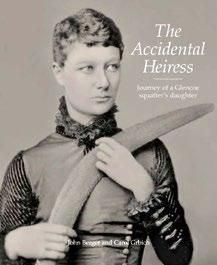
1 minute read
The Accidental Heiress
A recently-published book written by volunteers from the National Trust’s Glencoe branch, explores the murky past of the Leake family, and the surprising life of a young colonial woman, who inherited their fortune.
The front cover of The Accidental Heiress carries an extraordinary 19th-century photographic portrait of a young woman with a steady gaze and unconventional cropped hair, holding a boomerang. Letitia Sarah Leake was the daughter of Edward Leake, who established Glencoe station in 1844 with his older brother, Robert.
Advertisement

Uncovering her tale began with the simple idea of writing a short story about the people who built Glencoe woolshed, which was donated to the National Trust in 1976 by Scotty Kennedy. When research uncovered some surprising and scandalous information, the story turned into a book authored by John Berger and Carol Grbich.
Robert and Edward were sons of a successful merchant family, who settled in Tasmania in the 1820s. The two brothers came to South Australia soon after it was settled, and eventually settled on land around Lake Leake, where they established an estate covering some 630 square kilometres.
Robert was a serious minded man, but Edward took a fancy to a young Irish girl already married to a bullocky. After the bullocky mysteriously disappeared, Edward proposed. When Robert died childless, Edward inherited Glencoe where he built one of the finest woolsheds in the colony in 1863. He died four years later and left the bulk of his estate to his seven-year-old daughter. Letitia came into her inheritance when she turned 21. A few years later the estate was sold to the Riddoch brothers for the equivalent of $25 million today. As a wealthy woman, Letitia had many suitors, but she took her time before settling on Charles Billyard, a lawyer and son of the New South Wales Solicitor General.
When the honeymoon was over, Charles examined Letitia’s finances and found some irregularities. He demanded restitution from the trustees, which led to acrimonious legal proceedings against Letitia’s family and the banks, who conspired to discredit her rights to the entire estate. They hired a lawyer to find proof she was illegitimate and investigate her father’s possible involvement in the bullocky’s death. The investigations turned up a lot of malicious gossip and hearsay but no solid evidence and the matter was settled out of court in Letitia’s favour.
After the dust had settled, she and Charles left Australia and bought Harefield Park in England. When war broke out in 1914, they offered the property to the Australian government as a hospital for Australian soldiers. Having lived an extraorindary life that took her from the isolated bush of the South East to high society in England, Letitia died in 1923 at the age of 64.



